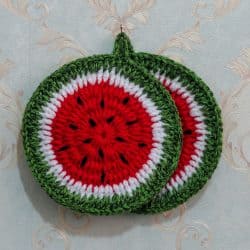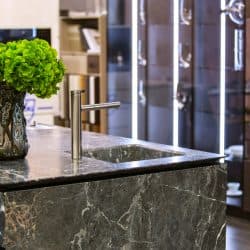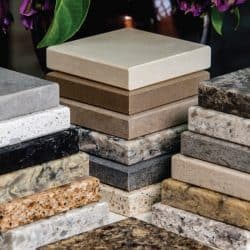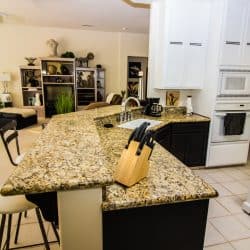There is no denying that granite countertops are some of the most premium looking countertops you can find. They all look classy and are, of course, incredibly durable. However, there is a minor issue you might run into when installing them. If you have a countertop that is longer than ten feet, you will end up having seams, also known in the industry as a "joinery." So, what should seams in granite countertops look like? We've done the work to bring you the answer.
The seam, or joinery, in a granite countertop, should blend in perfectly, making it practically invisible to the naked eye. There may be times when it will be difficult to hide the seam; however, taking some time to address the layout of the countertop will allow you to minimize issues when installing a granite countertop to make the seam disappear and blend in easily.
With more home buyers wanting more counter space, seams are an unavoidable thing. There are lots of tricks of the trade to make the seam disappear. Below are our recommendations when dealing with seams, how to plan the layout to minimize the number of seams, what you need to be aware of when installing a countertop, and what other nuances you should know. Let's get into it, shall we?

What Seams In A Granite Countertop Should Look Like
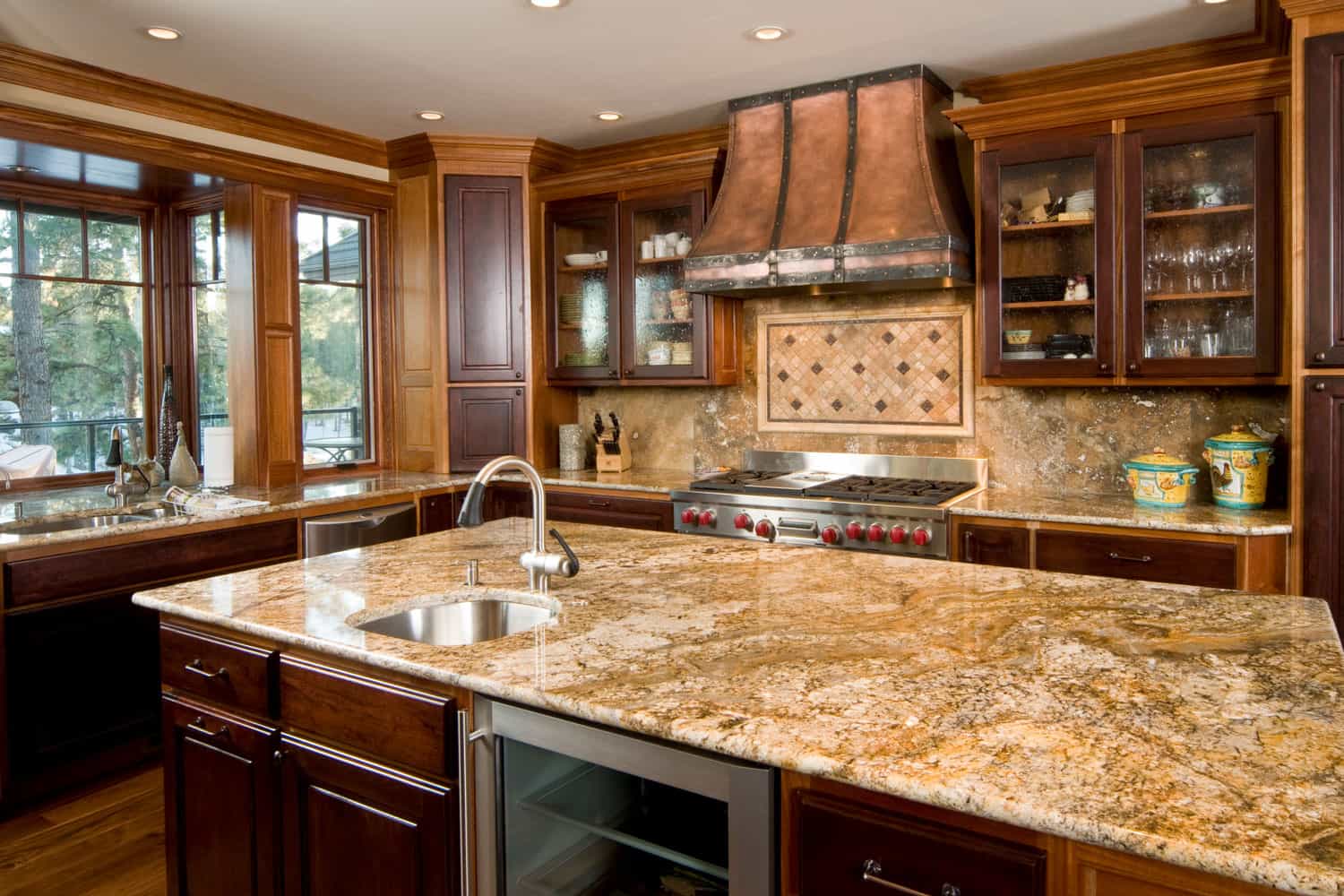
First, we must answer what a seam is in granite. A seam is essentially a junction where two slabs of granite connect. This creates a small gap or space that may affect the appearance. If you have a large home, with lots of counter space, you will likely have seams. This is because the slab of granite comes in 9 or 10-foot lengths. So, a countertop that is longer than 10 feet will need two slabs of granite pushed together to make one continuous countertop.
The seams in your granite, regardless of how long the countertop is, should blend in, ahem, seamlessly. Let's discuss this in more detail.
How Should You Layout Your Countertop?
The seam layout is extremely critical to the countertops' overall look and feel when completed. You want to make sure that you have a complete understanding of where each seam might be and how they will affect the granite's appearance.
This will be true when you are looking to install high-end stone slabs that have veins and movement to its surface structure. Have a rough drawing of what your countertop looks like so that you can plan the layout accordingly. Exact measurements will be important to guide you with seam placement.
How Are Seams Created?
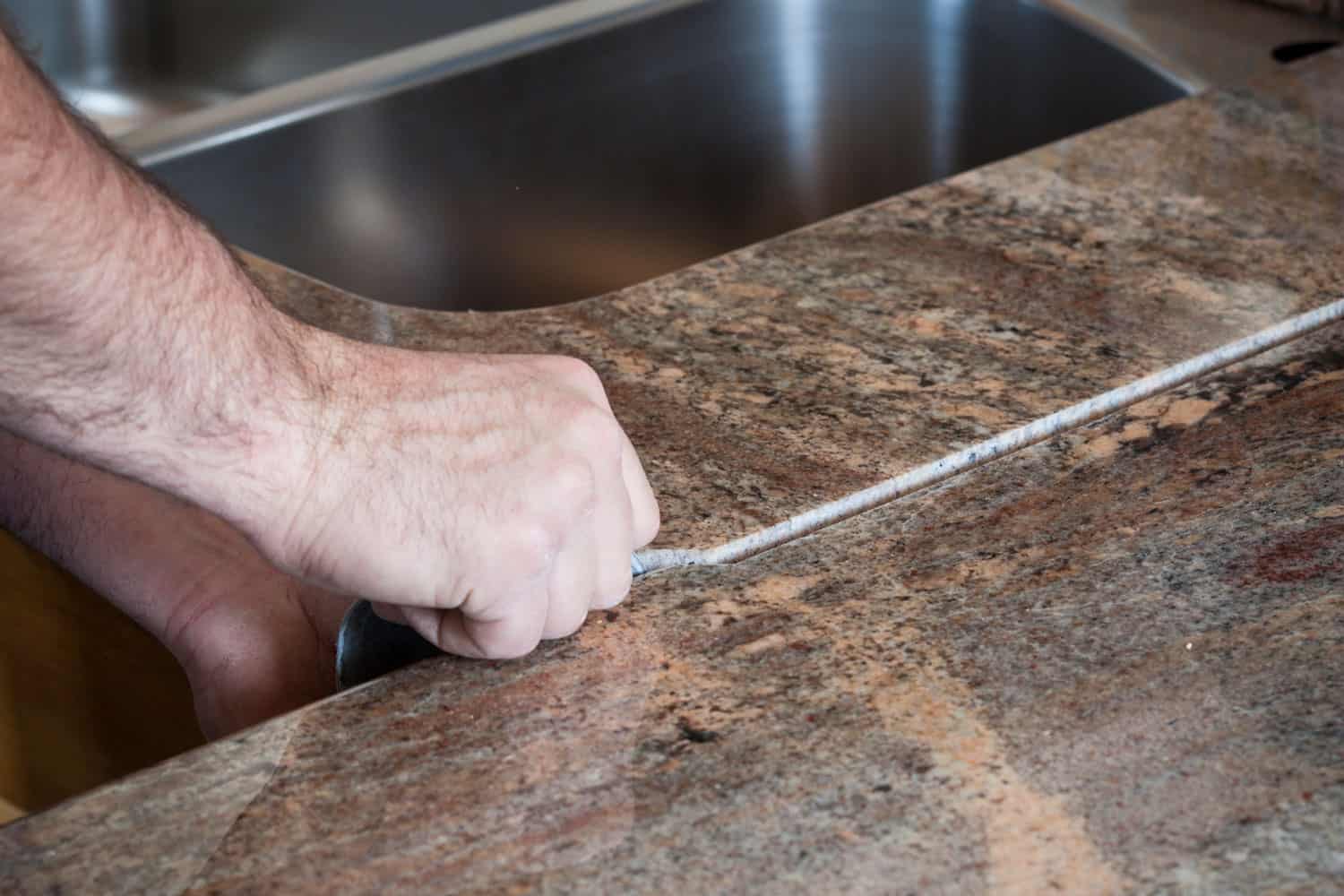
A seam is formed when the countertop space requires more than one slab of granite to connect at a corner or extend the countertop beyond 10 feet in length. You create a seam when you join the two together. A resin is then applied to the seam to connect the two sections together and as an adhesive to bond them. Once set, the resin now becomes the seam.
If you need to get a seam installed, you'll need to follow a set of steps. This will ensure that the countertop is as strong as possible. First, the pieces will need to be measured and cut. Refer to the section above on layout design.
Ensure that the hole for the sink has been cut and accounted for. Lay the different sections down to ensure proper fit and placement. It is recommended that you hire a professional to work with granite countertops since they can crack if not handled properly. They also may have some tools that will hold the sections in place to form a tight seam.
You should have a seam that is less than 1/16" of an inch when joining two pieces together. This is the width recommended by the Marble Institute of America. A seam that is slightly larger is recommended when connecting to a wall or plywood. Use caulk to waterproof the seams between the wall or plywood.
What Can Make A Bad Seam?
There are a few things that can create a bad seam. One of the biggest issues is when the granite sections are not the same size. Another potential issue is when they haven't been joined properly by a fresh coat of resin adhesive, or the color makes it stand out.
There are a few things which can result in a bad seam. However, one of the biggest problems occurs when the two pieces of granite are not sealed at the same height. If they aren't, it will create a lumpy seam. This can have the potential to trap food, which can cause the growth of bacteria.
Another thing that can create a bad seam is the type of sealant used. As we mentioned earlier, silicone has the potential to stretch and crack over time. This can cause big problems down the road.
Even if you use the right epoxy or resin adhesive, picking the wrong color can make the seam look noticeable. While this won't cause any structural issues, it can still make the countertop look less appealing.
Do All Granite Countertops Have Seams?
Not all granite countertops have a seam. However, if you're working with a larger space, you will often need to use a seam. A seam will also need to be used if there are corner pieces that need to be joined.
There are a few factors that will determine whether or not you need to have a seam on your granite countertop. First is the size of the countertop. If you have a smaller surface area, like in a bathroom, you might not need to put in a seam. The size of an average granite stone slab is around 10-feet long; if your counter is longer than this, there will need to be a seam.
The other thing that you'll need to consider will be the shape of the countertop. If you want to put it in a corner, you'll have a seam when joining the two sides together. Granite slabs come in rectangular shapes and any corner pieces will need to be cut, and therefore, will have a joinery in each corner at a 45-degree cut to make the 90-degree angle.
To form the angle correctly, the installer must cut the granite and join the two pieces together. However, there are a few ways that they can do this, depending on the type of countertop that you want to create. First, they can cut two rectangular pieces, to form an L-shape. Then, they will butt the two pieces together to form the square corner.
Alternatively, they might want to cut each piece at a 45-degree angle, joining the two pieces in the corner at the cut. This is known as a mitered corner and gives the countertop a unique look. The right type of technique will depend on the type of countertop you want to have.
Is It Okay To Have A Seam Near The Sink?
![]()
When deciding where to put a seam, you should avoid putting it near the sink cut out. This will weaken the structural integrity of the granite. Over time, this has the potential to lead to cracking. This can mean that you'll need to replace the granite, which can be costly after the fact.
If possible, limit the length of the seam. The longer the seam, the more noticeable it will be; however, keep in mind the structural integrity of the overall slab when deciding on where to place a seam.
How Do You Fill Seams In Granite Countertops?
After some time, your house and all the components in it start to settle, which may cause you to see gaps in the granite if not sealed properly. The filler material used can be a type of resin, either epoxy or polyester, with epoxy being the most common. You can also use grout or an elastomeric sealant, which are usually applied at a section connected to cabinetry or gypsum board.
Check out this sealant on Amazon.
To fill the seams, apply the epoxy resin liberally to the seam, wiping off any excess. It is important to note that you must use suction cups or commercially available stone-alignment tools that allow for movements in the millimeter ranges. Manually aligning the seams can be problematic if not done properly.
How Do You Fix Uneven Granite Seams?
"Lippage," as it is known in the industry, is the unevenness of the granite seams when pushed together. Lippage is common and might be unavoidable depending on the situation. The biggest cause of lippage is the warping of the slab. Ideally, there should be no detectable lippage at the front or rear edge of the countertop.
If there are uneven seams in the middle of the granite, some extra adhesive and a bit of pressure may be able to fix it. A word of caution; when manipulating the granite, be aware that too much pressure on the seam could cause it to crack and break if not done properly. We recommend using a professional installer to help you.
Does Gorilla Glue Work On Granite?
The brand Gorilla Glue does make a Gorilla epoxy product that will work as a filler material that can fill gaps up to 1/16 of an inch. An epoxy-type resin is best suited for granite because of its bond strength.
Check out this Gorilla Glue epoxy on Amazon.
What Is The Best Adhesive For Granite?
As noted above, epoxy resin is the best adhesive for granite because of its strong bonding capabilities. When installing granite countertops, they must be glued down since you cannot use a metal fastener (screw, nail, etc.) or you risk cracking the granite.
Final Thoughts
When installing a granite countertop, you'll often need to put in a seam. This will ensure that the granite will join together properly and give you that uniform look you want. A good seam shouldn't be noticeable. The sealant should be the same color as the granite and it should be in an inconspicuous place. If you do this, you'll be able to enjoy the beauty of your granite countertop for a lifetime.
For more guidance on granite countertops, check out these articles:
Do Granite Countertops Need To Be Sealed? [And How To Do That]
How To Clean Granite Countertops? [3 Steps]



![An empty kitchen with a granite island countertop with wooden flooring, How To Clean Granite Countertops? [3 Steps]](https://kitchenseer.com/wp-content/uploads/2020/10/An-empty-kitchen-with-a-granite-island-countertop-with-wooden-flooring-250x250.jpg)

